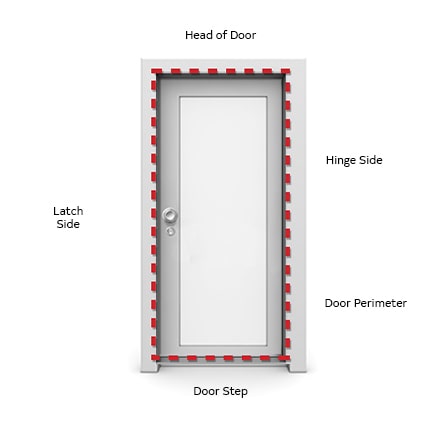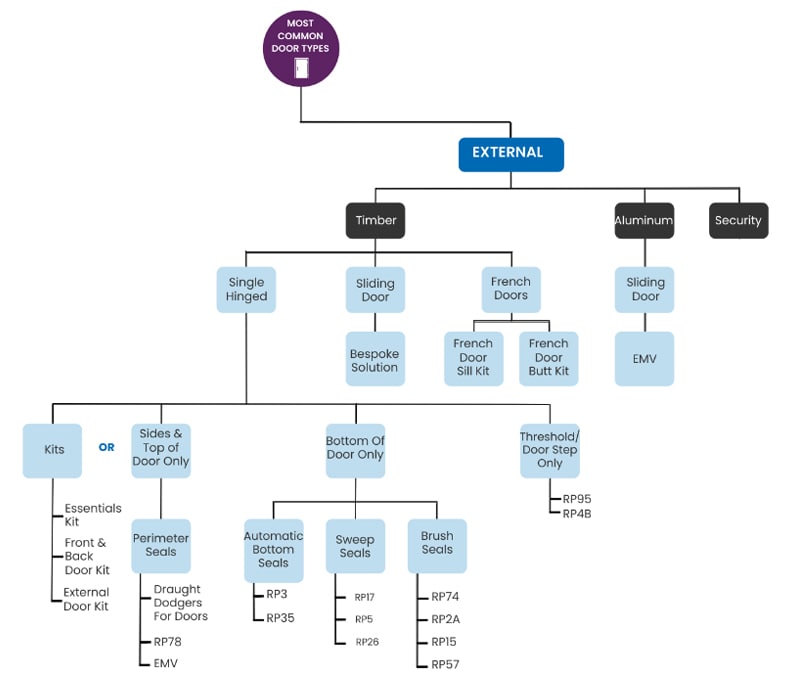Door Seals
Guide to Draught Proofing Doors

Having a well draught proofed/sealed door is something to smile about
Doors are an essential part of any home and apart from obviously providing access to, from and around your home, they are a primary source of ventilation, privacy and aesthetics.
Doors are also well known for letting in draughts and being an open invitation for snakes, insects, and other creatures to enter your home.
If a door is draughty your inside temperature is going to be uncomfortable which will drastically affect your energy bills as you attempt to regulate the temperature indoors throughout the seasons.
Fixing a draughty door is something most people can do themselves, particularly with ecoMaster’s ‘how to’ videos.
ecoMaster does not recommend basic stick-on weather stripping, commonly found in most hardware stores. It is designed to fit in the gap between the door and the door jamb, but that gap can be highly variable, and weather stripping only works on a very small range of gap.
This means that weather stripping frequently doesn’t work very well. It often doesn’t properly fill the gap, or, if you add more, it over-fills the gap and you can’t shut the door. Over time the stuffing of weather stripping in a door can actually warp the door, resulting in a bananas shaped door that is even more difficult to draught seal.

A beautifully maintained traditional wooden home in Colac, Australia.
When renovating or maintaining your home remember the importance of quality Draught Proofing.

What type of External Doors are in your home?
The most common types of doors found in a home are:
 1. Single Hinged Doors – are by far the most common type of door – as external and internal doors. A single door that is hinged to the door frame.
1. Single Hinged Doors – are by far the most common type of door – as external and internal doors. A single door that is hinged to the door frame.
 2. French Door – also known as Combo, Double or Barn Doors. These types of doors are beautiful but notoriously draughty. They create a wider opening and give you the option of opening just one or both doors to allow cooling breezes into the house.
2. French Door – also known as Combo, Double or Barn Doors. These types of doors are beautiful but notoriously draughty. They create a wider opening and give you the option of opening just one or both doors to allow cooling breezes into the house.  3. Aluminium Sliding Doors – are usually glass doors that lead to a deck or patio. They can also be used indoor as well and can be a great way to divide spaces or open them up.
3. Aluminium Sliding Doors – are usually glass doors that lead to a deck or patio. They can also be used indoor as well and can be a great way to divide spaces or open them up. 4. Sliding Doors – are mostly used for interior spaces where hinged doors would take up too much space.
4. Sliding Doors – are mostly used for interior spaces where hinged doors would take up too much space.  5. Security Doors – allow you to safely open up your home and let natural ventilation in. But some intruders can slip into your home under a gap in your security door. Insects, spiders, rodents and snakes would be delighted to take up residence in your home.
5. Security Doors – allow you to safely open up your home and let natural ventilation in. But some intruders can slip into your home under a gap in your security door. Insects, spiders, rodents and snakes would be delighted to take up residence in your home. Pivot doors – are not particularly common and have their own particular set of unique challenges. Instead of the hinges being mounted on the side of the door they are mounted on the top and bottom side and rotate on a vertical axis. Usually, these are an architectural “statement” for the home. Check out this blog on draught proofing Pivot Doors.

What Type of Internal Doors Are In Your Home?
The most common types of doors found in a home are:
 1. Single Hinged – are by far the most common type of door. A single door that is hinged on one side to the door frame.
1. Single Hinged – are by far the most common type of door. A single door that is hinged on one side to the door frame.

2. Cavity Sliding – are mostly used for interior spaces where hinged doors would take up too much space. They are generally Cavity Sliding Doors and can be found as an access from an internal garage door to the living aeas, entry to a laundry, WIR or ensuite.


The Anatomy of a Door
Doors can be quite complex. So before we can work out WHAT you need to draught proof your door, we need to name the various parts of a door, so you know what you are working with. If you are dealing with someone who is trying to advise you on the right solution for your door, or you are searching for solutions online, it is good to be describing your situation in commonly known terms.
Terminology of Door Seal Solutions
Draught Excluder – goes on the bottom of a door to stop under the door draughts. Many people use the term “draught stopper”.
Treadplate – goes on the doorstep to make a flat, secure surface for your Draught Excluder to touch. If your doorstep is uneven, it will be very difficult to achieve a thoroughly draught-proofed door.
Perimeter Seal – goes around the sides and top of a door. Because doors have 4 sides, you will need to draught proof all four sides to achieve a thoroughly draught-proofed door.

Door Seals for Single Hinged Doors
What Do I Need to Draught Proof My Single Hinged Doors?
There are potentially three areas that will need attention to create a draught free external single hinged door.
Treadplate – If your doorstep is not flat, you may need a treadplate.
Draught Excluders – for the bottom of your doors, an essential part of finishing off any door for draughts and other protections. There are many different kinds available for different needs.
Perimeter Seals – for the sides and top of your door. There are three types of perimeter seals:
Draught Dodgers – all weather, foolproof door seals that protect your home from intrusive draughts but do not sacrifice good looks. They can be fitted to draught proof VARIABLE GAPS from the top to the bottom of a door including warped doors, doors that shift in size between summer and winter or doors that move from side to side as homes shift.
EMV – for aluminium sliding doors is the answer you’ve been looking for. The EMV perimeter seal can seal gaps and cracks that vary in width around your aluminium sliding door. EMV is a quick, easy and durable sliding door seal.
Raven RP78 – the RP78Si is a medium temperature, smoke door frame seal made with acoustics in mind. It is specifically designed to be installed on door stops. It is constructed from aluminium carrier with slots that allow for easy adjustment with hidden fixings.

The simple guide to what you need to draught proof your internal doors

Draught Proofing for Door Bottoms
Automated Draft Excluders for door bottoms
Which draught excluder to use when fixing draughts at the bottom of a door?
If the home is in a windy area use an automatic bottom door excluder.
For more general and internal doors use an RP 35.

Draught Proofing for Door Bottoms
Which brush seal to use when fixing draughty doors
Brushes can be an easy and relatively effective option to seal the bottom of a door onto a hard surface.
There are different brush lengths to suit most gap sizes.
Best used for internal doors and external timber sliding doors.
All are self adhesive, but some can be screw fixed.
Mostly, do not use over carpet.
Brushes are ALWAYS black – no other brush colour choices.
The ‘colour’ refers to the carrier.

Draught Proofing for Door Bottoms
Which sweep seals to use on the bottom of draughty doors

Perimeter Seals for Door sides and top
Which perimeter seal to use around draughty doors?

French Doors – DIY made easy
Which French Door Kit to use to seal draughty French Doors?

